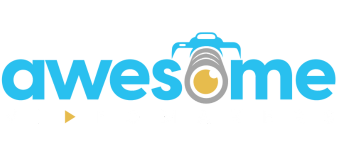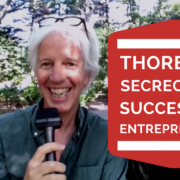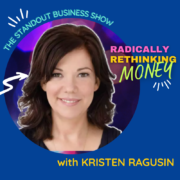156. Change the Conversation About Your Business with Jaci Russo
My guest this week is brand strategist, Jaci Russo and my biggest takeaway from our conversation was her take on the most basic way to explain branding:
“We don’t see things as they are. We see things as we are.”
Jaci says, Your clients don’t see your company as it is. If they know of your company at all, they only see a small sliver of it from their perspective.
That’s why you say things like, “If prospects just understood what we do they would want our products/services.”
But, you’ll lose them when you try to “educate” them on who you are and how you work and why you’re great.
Those kinds of messages are just more noise for them to ignore.
You need to understand more about your target audience, their buyer’s journey, and have a message that will cut through the clutter and connect with them.You need to change the conversation & show them how you’re different.
Listen up because Jaci walked us through her process of building a brand that changes the conversation, via her 4-step Razor Branding process, that will help you clearly define the promise behind your brand, and help your customers more easily understand how your product or service will enhance their lives.
Resources
Get my new FREE training: The Art of the 5-Minute Video
Transcript
Jaci Russo:
People don’t want to be educated, they want to be wooed, they want to be entertained, they want to be captivated, they want to, above all else, they want to be understood, and so when you clearly indicate that you get them, you understand their challenge, you have a specific, unique, special, different solution to their challenge. You are a guide that is here to solve whatever issue that they’re in. That is when they’re going to be willing to give you the time of day, the time and space to connect with them.
Brad Powell:
Here is the most basic way to explain branding. We don’t see things as they are. We see things as we are. Your clients don’t see your company as it is. If they know anything about you at all, they only see this tiny sliver, and it’s from their perspective, which is why you end up saying things like if prospects just understood what we do, they would want our products and services. But you lose them when you try to educate them on who you are and how you work and why you’re so great. These kinds of messages are just much more noise and much more stuff for them to completely ignore. So what do you do? You need to change the conversation you’re having and show them how you’re different.
Brad Powell:
Welcome to the Standout Business Show, where it’s all about making a bigger difference by doing business differently. I’m Brad Powell, and today I’ve invited branding expert Jackie Russo onto the show to walk us through her process of building a brand that changes the conversation. So stay tuned, because Jackie’s going to walk us through her four-step process that she calls Razor Branding. That’s going to help you clearly define the promise of your brand and with that let’s start the show. All right, Jackie, welcome to the show.
Jaci Russo:
Thanks, brad, I’m glad to be here.
Brad Powell:
Yeah, and so to the show. Thanks, brad, I’m glad to be here. Yeah, and so changing the conversation. Okay, so let’s start from a place of the baseline, of what’s wrong with the conversation that’s going on right now.
Jaci Russo:
For some businesses, nothing. For some businesses, the conversation is awesome and they are in demand and people are lining up out the door to buy their products and services. People are lining up out the door to buy their products and services, but for the rest of us, the problem is either a best kept secret best kept secret in the industry People don’t know you, they don’t know who you are, they don’t understand why you’re great, they don’t have an awareness. Whatever they’re doing right now is working OK and they’re not willing to switch. Or your company has evolved and grown over time. You have new products and services, you have new offerings, you have new solutions, but people only know you for one thing, and so they haven’t expanded their knowledge of you. Or, entirely possible, they knew you at a time when you were not as good as you are now. You’ve grown, you’ve evolved, you’ve gotten better, and so any of those are places where you need to change the conversation.
Brad Powell:
Yeah, and I think the best kept secret is it’s like a plague. I mean, I think a lot of people in business that’s the way they feel, Both from a business perspective and actually personally, like if people only knew, if I only could reach, if I could only get that group of people who understand what the heck I do and why I think it’s so amazing, then everything would change. And that’s the problem that they think that they really need to solve. And so, from your perspective, why is some of that thinking a little bit misplaced and where’s the stuff that they should be doing?
Jaci Russo:
Well, I think the problem is a little bit misplaced in that they spend the time then talking about themselves. Let me tell you about my company. Let me tell you about what my company does. Let me give you a list of features about my company how old we are, how many employees we have, how much business we did last year.
Jaci Russo:
Thinking all of those things give them some sort of social proof or validation of greatness and therefore you will be attracted to them and choose them, when, in fact, they have stopped listening as soon as you started saying I, they are looking over your shoulder for who else they can talk to. Instead, when we say you, showing that we understand the target audience’s challenge, we understand their problems, we realize what they are grappling with and we have a specific solution to help them with that problem that is in many ways different and better than all the other solutions out there. Then, and only then, are you going to cut through the clutter and get their attention enough that they want to hear what you have to say and therefore be willing to select you, because choosing you means they have to let go of what they were doing before, and change is hard.
Brad Powell:
Yeah right, Exactly People. When you ask someone to change their mind, they generally respond by going nope, I’m not doing that. I’m digging in, you can’t change my mind, Forget it. Yeah, and I think this thing about listening more. You know, there’s a lot of ways that this can be done. People do things like well, we’re going to send a survey, or I’m going to ask my, my uncle Ralph what he thinks. I’m going to ask my uncle Ralph what he thinks, and that may not neither of those surveys definitely do work, but I think nothing beats actually talking to people and talking to them in a way where it’s much more conversational. So when you’re talking with clients, how do you suggest that they begin a listening process that’s actually going to do them some good?
Jaci Russo:
Well, there are a lot of different ways to listen. There’s social listening People talk online all the time, and so you should be able to get some opportunity for listening right there. There is a lot of available third-party research that you can access that can tell you what other people have heard that could be helpful to you. You can send out surveys, you can send out emails, you can do focus groups. But, brad, you’re right Ultimately, the best of all of those is to actually have conversations with active listening skills. So you aren’t just going for a yes or no answer, you aren’t leading the conversation in a certain direction, you’re not working towards a confirmation bias where you only listen to the things that support the way you thought walking into this.
Jaci Russo:
You truly listen, and for some people that’s really hard. It’s hard because they’re talking about their life’s work. They’re talking about a company that they know inside and out, and it’s unfathomable that the rest of the world doesn’t see that company the same way they do, because they’ve forgotten the number one principle of branding, which is that it’s an emotional connection of a person to the company, product or service. Therefore, it’s the person’s emotions. Therefore, your brand is in the heart of the beholder. It’s their brand of you, and so that’s how you can ask 100 people and get 100 different answers. So that’s how you can ask 100 people and get 100 different answers. But when we do listen, then we’re able to get a lot of information that can drive some of that messaging and really open up some opportunities. For some companies, it’s really truly too hard to do it for themselves, and so they need to use an outside third party. That’s the only way they’re going to get true, unbiased information.
Brad Powell:
That’s the only way they’re going to get true, unbiased information. Yeah, I think the way I think about starting conversation is really looking for the conversations that are out there that are already happening and learning about that and then being able to enter that conversation in a way that shows that you actually get other people and and then you can share like you can earn the right to share your own take on what’s being talked about Exactly, and this is really distinctive from educating. It’s like let me teach you something, Let me tell you what I know.
Jaci Russo:
People don’t want to be educated, they want to be wooed, they want to be entertained, they want to be captivated, they want to, above all else, they want to be understood, and so when you clearly indicate that you get them, you understand their challenge, you have a specific, unique, special, different solution to their challenge. You are a guide that is here to solve whatever issue that they’re in. That is when they’re going to be willing to give you the time of day, the time and space to connect with them. We have, over time, built up these incredible filters that block out everything that’s not directly relevant to where we are at this exact moment. And so I think about when I was having kids.
Jaci Russo:
I had four kids in four years, which don’t necessarily recommend. It’s not for the faint of heart, but that’s how these things go sometimes. And so in that time period, for the five years basically that I was pregnant, I saw baby stuff everywhere Baby bottles, baby books, baby carriages, baby clothes, baby diapers everything in my life was baby. I am quite certain the human species is maybe ceasing to exist because I haven’t seen a baby thing in 20 years, maybe ceasing to exist because I haven’t seen a baby thing in 20 years, baby things Are babies still made. Is it true that they’re not out there anymore? No, it’s just because it’s not in my scope. It no longer is in my radar, so I’m not seeing it.
Brad Powell:
If I’m not in the market for a red pickup truck, I don’t see red pickup trucks, but if I’m shopping for one, I see them everywhere. Exactly, we all know that. You know we buy a new car and then, all of a sudden, everybody on the highway seems to have the same car we have. I’d like to dive in a little bit on this razor branding process that I know you’ve coined. When most people think about branding, the first thing that they’re thinking of is something visual and the first place they feel like they need to go is like well, I need to get my color thing and I need to get a logo and probably I need to get a beautiful website these sort of very visual elements for a particular brand. But you’re talking about something really different in terms of this conversational approach to branding.
Jaci Russo:
You’re talking about something really different in terms of this conversational approach to branding. Well, yes and so. The brand identity, the visual representation of the brand, the name, the logo, the colors, the mark or bug all of that is a part of the brand. I think of brand as an umbrella and every handle that helps to hold that umbrella up and makes it bigger. The brand identity or logo is one of those handles. Your customer service, your pricing, your promotion, your products and services themselves, your true understanding of your target audience segment and how to solve their problem. The materials with which your products are made, every one of those things, every touch point, every place where someone interacts with you. The materials with which your products are made, every one of those things, every touch point, every place where someone interacts with you, is a chance to build or break your brand. So it’s a chance to make your umbrella bigger or smaller. Your brand identity, your logo, is the biggest of those umbrellas and it’s in the very center, and so it’s your balance. It’s the thing that helps you hold steady, and when we think about the logo, it is very important that it is something that is unique to you. If your logo looks like everybody else’s logo, how are they going to pick? You see the golden arches from miles away on an interstate and know Fun Meal fries. Go to playground ahead and you know, all of a sudden, the family car is pulling off at that exit. So we know the importance of logos. We can see it in ourselves. Our eyes light up when we see our favorite products. We wear the logos of our favorite products, or sports teams or schools or anything, and so that is absolutely the first place to start.
Jaci Russo:
And so you want to make sure it’s professionally designed, you want to make sure that it’s legally protected, you want to make sure that you have brand standards and guidelines around your brand identity so that everyone’s on the same page and you’re protecting that asset that is so valuable. But then you have to move on from there. That’s just foundational. Then you move into the rest of razor branding, and so the first of the four steps we call focus, and that is who are you focused on? Please forgive the grammatical inaccuracies of that sentence, but with whom doesn’t work as well. So who are you focused on? And so that is about demographics, that is about psychographics, that is about pain points, that is about personality profiles and that is about, above all else, being very clear and very niche and very specific in who you are reaching out to, because if you try to reach everyone, you will connect with no one.
Brad Powell:
Yeah, exactly. Well, the thing about focusing on a particular person is that when you are thinking about this ideal customer or client avatar or whatever demographic you’re going for, in my mind it’s not just the typical stuff 40 something mother with two kids who drives a Prius, who lives in whatever that that kind of information that can be helpful, but it’s more around what’s going on in their brain, like what we were talking about earlier, like what are they thinking? Did they just have three kids? You know like, and then what’s their mindset in that moment of time? And those kinds of things are much more around the trigger of what’s their intent. Are they in a place where they would like to buy the thing that you have?
Jaci Russo:
Well, for us, you know, as a media buyer, everything starts with demographics. We have to know all that outside stuff age, gender, number of kids, education level, income, geography, all of those things but we know that’s not really what motivates people. We just need that information to make an accurate media buy. So if you’re going to reach them through advertising digital, traditional, online, social, whatever it might be you’ll need that info to put together the buy.
Jaci Russo:
But the really strong way to connect with them is what we call psychographics. That’s everything on the inside. That’s how they think, how they feel, what they want, what they need, their pain points, their wishes, their desires. That’s how you’re really going to get them, because we’re talking about emotional connections, which is the basis of branding. That comes from psychographics, not demographics. We throw in personality profiles because people absorb information in different ways. Some people want pretty pictures, some people want lots of data, some people want testimonials from others, some people want a very short list. They will make a decision, trust their gut and go Four very different approaches and there’s no one size fits all. So you’ve got to know who you’re talking to, to understand what information to give to them and then how that information needs to be delivered.
Brad Powell:
Yeah, okay. Well, I’ve got a little cheat sheet here because I know the four parts of the Razor branding, so the next one is promise. So how do you define that part?
Jaci Russo:
This is why they should choose you. You should be able to fill in the blank of this sentence. We are the only blank that does blank, and people get real stumped here because they think, well, I’m a shoe store and there’s a lot of shoe stores and all of us have Nikes, so I don’t really know that there’s anything unique to me, so I’m just going to lower my prices. Well, that is a recipe that could get you some short-term attention and some sales that maybe are lost leaders, but that’s going to turn you into a commodity, and when someone else lowers their prices a little lower than yours all of a sudden, that’s not a sales strategy that’s going to work very well. Ask Circuit City or Bed Bath Beyond with those big blue coupons.
Jaci Russo:
Instead of turning yourself into a commodity and fighting a price battle that you will ultimately lose, you need to find a different point of differentiation, to find a way to separate yourself from the herd, because humans are a herd species. We travel in packs, just like antelope and deer and elephants, and we do that for safety and security. It’s in our DNA, it’s the reason why we form community. It’s the reason why you find a group of high school kids that all kind of look and sound and dress just like each other. There’s a herd and so we know that is part of our brain.
Jaci Russo:
That is necessary, but in business it is awful. So you have to go against your human instincts for your business instincts. And the business says be different, stand out, otherwise you cannot be chosen. So find a way to fill in the. We are the only blank that does blank and there’s got to be some point of differentiation for you in there somewhere, and that point of differentiation has to be beneficial to the target audience. So if you’re the only building on the block that’s yellow, I don’t know that that’s really providing a strong reason for someone to come to you. You’ve got to give them a reason.
Brad Powell:
Well, first of all, that’s a really great point of departure. We’re the only thing of this type that does this other thing of this other type, and I think I know that the next part of this is connection, and I just want to tie this together. One thing that Seth Godin says in the same frame is people like us do things like this, which is really similar. But it is more about actually making the connection with your people so that not only do they feel like, oh, this is different, but they feel like this is for me and it’s for people like me.
Brad Powell:
And that’s this is where the connection part comes in. So talk a little bit more about this whole connecting piece.
Jaci Russo:
Well, that’s number three. That is connection, and what connection does is forms the message. So it takes the differentiation that you’ve built out under promise. You know, we promise you we’re going to be different in this way. We promise you this certain experience. Now we’re going to be different in this way. We promise you this certain experience. Often, that’s an internal message. Now we’re going to turn it into an external message. What I think Seth does well but misses kind of that last little piece is us is still a little bit talking about me. Instead, in connection, we want to completely talk about them. This is your challenge, this is your problem, this is the pain you are suffering. This is the thing you’re frustrated with. This is a way that it can be solved. We’re the guide that gets you to that solution. So it’s way more about them, what they’re going through, and you show that. You get them, you see them, you hear them, you understand them and you know how to help them solve this problem.
Brad Powell:
That’s great. I like that. That’s really a great extra step. It’s really narrowing in. It’s all about you and your problem and I feel your pain. All right, well, let’s go to step number four here, which, as I look at my sheet here, is all about harmony, which is terrific. Let’s, let’s get there.
Jaci Russo:
Well, it’s harmony for a couple of reasons. It’s harmony because we want all the pieces to work together and so they need to be in harmony. It’s also harmony because when you do it right, it sings, it just feels good, you can tell. And so we see a lot of businesses who will go over here and say and do one thing, and then go over there and say and do something else. That’s not harmony. Those two things are going to come back to bite you because they’re contradictory. So you need to be the same everywhere, because you need to be reaching the one target audience that you’ve prioritized, that you’re really focused on right now. And so then it’s where are those people? I use this example often, but it’s so stunning to me how clear it was to me at least, but not to everyone else.
Jaci Russo:
I’m working with a large client. I’m at a board meeting. One of the board members, who is a gentleman in his 70s, says my great grandson is on Snapchat. I think we should be on Snapchat, and I said well, your great grandson is 12. And he’s, quite honestly, too young to be on Snapchat. But that’s a different discussion for a different day.
Jaci Russo:
The target audience of your business is 50. And so if I will show you the statistics on how many 50 year olds were on Snapchat at this time, and I think you’ll agree with me that that’s not the right place, and so often we see people try to pick the tactical experience where they’re going to put out their messages based on them, whatever they are watching or listening or reading to, or a great grandchild but very rarely do they do the real work of understanding where their target audience is, and so instead they get spread out way too thin, or they spend the money in the wrong places or they put it in places where it cannot be tracked and monitored, measured and then modified to work better, and so harmony is about all of those things aligning so that they work well together. It should be better than the sum of its parts.
Brad Powell:
And it’s really tricky to pull things together, especially now, I mean, when people think about doing anything in the realm of online marketing. Every channel that you can consider is like a different animal, and I mean the difference between LinkedIn and TikTok is light years in terms of just who’s there and how it functions and what you may or may not want to be doing on either of those two platforms.
Jaci Russo:
Right Night and day.
Brad Powell:
Night and day. Well, you know, I’m going to go back to our original thing about changing the conversation and when you’re talking about showing up for people as if you understand them and so that they get the feeling that you’re almost inside their head, and this thing about acting like a guide for me, sometimes I’ve seen examples where people are going a little bit further than that and becoming kind of a champion for the people that they’re serving and taking on that role a little bit in the way that they speak, you know, in the conversations that they’re having. And I’ll give you one quick example of this One of the people that I worked with a couple of years ago. She was on LinkedIn primarily, and she was consulted for sales teams. That’s what she was doing and she wanted to start making video on LinkedIn. And I said, well, go out there and just see what people are talking about and when you see something interesting to you that, like you know, just get your going in some way, like that you can respond, to make a response video to whatever you see, because that’ll be you entering a conversation that’s already happening.
Brad Powell:
So what she did was she found a post by some CEO who, in this case was like publicly shaming one of their sales reps and literally had a screenshot there in the post of, like this is what this person did and why I don’t like it and was really, you know, cutting them down.
Brad Powell:
And so she made a post and she didn’t, you know, name the guy or anything like that. But she said I saw this and this is what I think about it and then started saying you know, and you guys in the sales crew like, hang in there, because I know it’s hard. You know, and if you’re a leader of a sales team, you need to really treat your salespeople like gold because they’re working hard for you. So she had this champion role in that and that this is the first thing that she’d ever done like this on video. And it just got tons of engagement of people chiming in saying you know this and that, and even other CEOs were talking about leadership and their attitude for it. So it just opened up this really big conversation that wanted to happen. That was really wanting to happen. So talk a little bit about that in terms of the kinds of things that you see either yourself or your clients are doing in this realm.
Jaci Russo:
Well, one of the things that I see happening most often is that companies use their own language, the language of their industry, the language of their company, and it is a specific language, and you can tell they haven’t really listened to their target audience and if they were, they would be using the words of their target audience in their messaging. That’s why the first step is so important Having those conversations, understanding the challenges that your target audience is going through and how you can alleviate some of that. Alleviate some of that. Then you use some of their words and phrases to say hey, we heard you, we listened. Here we are.
Jaci Russo:
Now you’re using their language to reach them and it’s something so simple, as in my industry, we call it brand identity, the rest of the world calls it logo. So if I only did search engine optimization around brand identity, I’m going to reach other people in the industry, but I’m not going to reach my target audience because they don’t say brand identity. I’m going to reach other people in the industry, but I’m not going to reach my target audience because they don’t say brand identity, they say logo. So knowing the language matters and that shows up in search engine optimization and messaging and all of the copy that you write in your social media posts and everything. So that’s why the first step is listening to your target audience segment.
Brad Powell:
Yeah, listening and using their words. Using their words really critical, All right. Well, we are getting close to the end of our time today. If there is one thing that we haven’t touched on or need to go a little bit deeper on, or some other note of inspiration that you have, what would that be?
Jaci Russo:
I would say that as 24 starts to wind down and you plan for 25, assume that you should make major changes to your marketing, because if you’re doing something that you were doing three, four, five years ago, it’s not going to be as effective anymore and it’s time to assess and better invest that budget next year.
Brad Powell:
Right Time to take a look at what you’re doing, marketing wise, and figure out something a little bit new, right? Well, jackie, this has been great. If people want to reach out to you, what’s the best way for them to connect?
Jaci Russo:
I’m at Jackie Russo and it’s spelled weird J-A-C-I-R-U-S-S-O. But you can find me on LinkedIn. You can go to JackieRussocom. I’m in all the places.
Brad Powell:
All right, well, I’ll make sure that links to your stuff are in the show notes. And, jackie, thank you so much for coming on today. This has been great.
Jaci Russo:
Thanks for having me, Brad.









